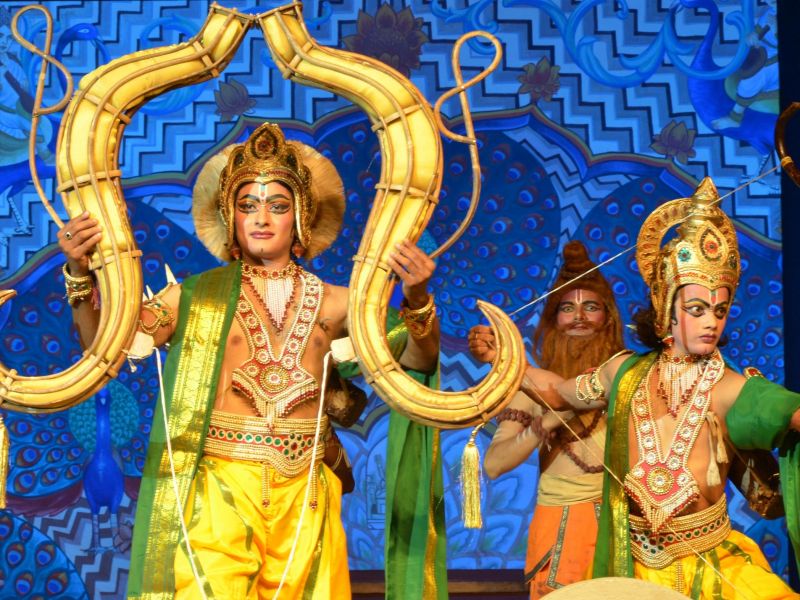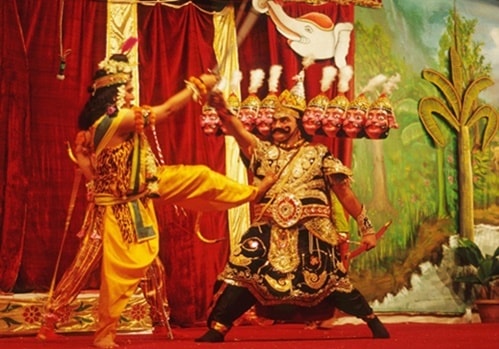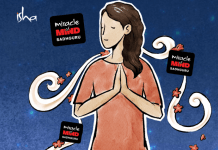By Dr Mital Makrand
The Ramayana is one of the greatest epics of Hindu Mythology written by the Hindu sage Valmiki. The underlying messages conveyed are the values and ideals, particularly in relation to duty, morality and social responsibility. It is a function of the many genres, the many languages, many occasions across Asia, on which the Ramayana is performed – like India, Indonesia, Thailand, Cambodia, etc.
The most popular folk media format in India, through which the indigenous cultural values of Ramayana are communicated, is the Ramlila.
When I say communication, I mean the act or process of using words, sounds, signs, or behaviors to express or exchange information or to express ideas, thoughts, feelings, etc., to someone else. Indigenous is something originating or occurring naturally in a particular place, region or country; native. Culture refers to a set of values, ideas, artifacts and other meaningful symbols that help individuals to communicate, interpret and evaluate as members of society. It is a normally homogeneous system of collectively shared meanings, way of life and common set of values shared by a member of society. Culture is the complex and elaborate system of meaning and behavior that defines the way of life for a group or society. Values a person’s principles or standards of behavior; one’s judgment of what is important in life. Folk Media refers to traditional media based on sound, image and sign language. It is expressed in the form of traditional music, drama, dance and puppetry.
Ramlila is a Hindu folk drama, representing episodes from the Ramayana and commemorating the victory of Rama over Ravana. The Ramayana and the Mahabharata are epics that have been an integral part of the Indian consciousness for the longest time. This form of theater was religious in nature. The audience went to watch them as if they were going to temples for it was a belief that the gods themselves descended into the actors performing them. With the passage of time the role of such theater forms changed.
The Ramayana is the delineation of life’s softer emotions, presenting an idealized world. The simple family relations like the relations between father and son, brother and brother, husband and wife are raised to such an ideal height as to become the subject of an epic. Loving brothers are still Ram-Lakshman, ideal couple is still Ram-Sita and the exile (vanavasa) and the Lakshmanrekha carry a weight of meaning which is proverbial in sense. Ram is a model for human behavior. He is the perfect man, an ideal toward which ordinary mortals should strive. Ram has come to be regarded in India as the great exemplar of devoted monogamous married love. A true son and ‘ideal man,’ who subordinates the goals of his own life to those of his father. He is the ideal of self control.
Sita is an icon of single minded devotion for her husband, of purity and self sacrifice.
Ravan, for example, is a metaphor for evil who can be discerned in the areas of military, politics, economics as well as in the small units of family.
We come across Ram as striving to fight Ravan, the ‘evil’ and to establish peace and protect justice. The Ramayana is a story of annihilation of evil, the ultimate triumph of the good, the inevitability of separation and exiles, quest for perfection and a struggle to establish ideals of life. The Ramayana has become a living element in the lives of Indians, ever pulling even the unread masses up from the drudgery and the ugliness of their everyday existence to higher realms pointing towards a righteous living.
Ramlila originated under the influence of the Bhakti Movement, characterized by an upsurge of the devotional fervor between the 15th and 17th centuries. Storytellers, epic-singers, temple pundits and school teachers, and any number of unknown tellers and tellings, the Ramayana is spoken, chanted, sung, mimed, retold, and explained. One form that the telling (or rather the ‘performing’) of the Ramayana is the Hindi folk form or traditional form of Ramlila. (http://www.dmd27.org/smriti.html) It is a folk form that is enacted every year during the Dussehra festival during the months of September or October. The festival celebrates the defeat of Ravana at the hands of Rama and symbolises archetypal victory of the good over evil.
The Ramlila performed in Varanasi and Ramnagar are considered to be the most famous and colorful of all in the North of India. The Ramnagar Ramlila specifically is a large-scale folk-drama production staged like a spectacle, under the patronage of the ‘Maharaja’ of Benaras, which of course explains the hype and the pomp around the Ramnagar Ramlila.
There are many small troupes that belong to different villages, cities, towns and even mohallas or localities, which do not get as much academic/scholarly attention as the Ramnagar Ramlila. These smaller scale productions are regionally localized and might differ from one another in their styles and flavors. The scale of these local versions of the Ramlila may be small when compared to the Ramnagar Ramlila, but they are similar to the latter in that they are open-air (not necessarily peripatetic like the Ramanagar lila) performances, and that their scripts are based on Tulsidas’ Ramcharitmanas and not on Valmiki’s text. This could be partly explained by the regional popularity of Tulsi’s version in the heartland of India. However, the Ramlila is not bound to an area or region. It is performed all over the country and in different guises, each performance interpreting the religious stories in different ways.
It observed that Ramayana is valued for the superlative ideals it extols. Ideal father, ideal son, ideal husband, ideal ruler, all male ideals are equated with Rama. At the same time, Sita in India or ‘Shinta’ in Indonesia is held an epitome of all ideals of womanhood. Hanuman is a loyal and dedicated devotee, Laksmana and Bharata are ideal brothers and so on.
Folk media being live and realistic will appeal to the target group. So, Ram as a persona and his deeds as a human being will need to be a repetitive-tale and role model for every generation.
- It is an educational medium used by the ancient sages to espouse the importance of doing your dharma (duty) in relationships; this folk media of storytelling can be adapted by new media technology and can be taught to the new generation for the effective reach of value-based communication.
- Deeds and lives of the characters portray them as heroes by their superhuman deeds, irrespective of their gender.
- The epic has lessons in the presentation of motives, actions and reactions, which are applicable for all times and all human conditions of life. It teaches us to lead a morally and spiritually enriched life in this highly materialistic world.
- Ramayana regards dharma, one’s duty as more important than one’s emotions. Sacrifice in relationships, forgiveness, protecting the weak, equality of race and creed, compassion, universal brotherhood are the very values that are required in the world today and in every era.
Today’s virtual world-generation hardly finds a space for a realistic platform to share these lessons and values through a live communication, a dialogue of experience and a corner of emotion, which is Ramlila. With the number of televisions in India far outpacing the number of toilets – family time is now devoted to family television viewing together. TV content is created and broadcasted for commercial success, irrespective of violation of cultural values as it is market driven and TRP driven.
References:
- http://www.learnersdictionary.com/definition/communication
- http://www.merriam-webster.com/dictionary/soap%20opera
- https://web.stanford.edu/class/me214/presentations/Gordon_Hewitson_Pyo-CulturalValues.pdf
- http://en.banglapedia.org/index.php
- https://en.oxforddictionaries.com/definition/value
- https://en.oxforddictionaries.com/definition/ramlila
- http://www.sabrizain.org/malaya/library/effectoframayana.pdf
- http://www.dmd27.org/smriti.html
- http://shodhganga.inflibnet.ac.in/itstream/10603/95117/9/09_chapter3.pdf
- http://yogaformodernage.com/values-taught-ramayana/







